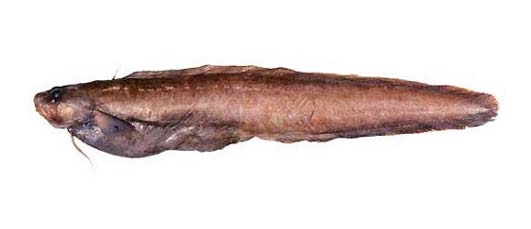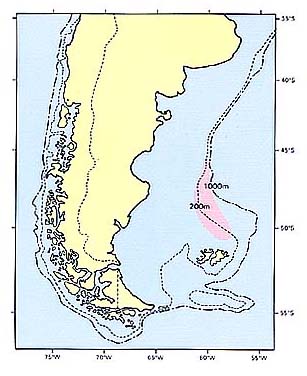ムレノレピス科
- HOME
- デジタル図鑑
- パタゴニア海域の重要水族
- 硬骨魚綱 タラ目
- ムレノレピス科
ムレノレピス科(Muraenolepididae)

23 ミナミウナギダラ(Minami-unagidara)
Muraenolepis orangiensis Vaillant, 1888
Yallich, lif, Yakouchlif (Arg.)
特 徴:
第1背鰭1棘,第2背鰭約160軟条,臀鰭約107軟条,胸鰭約32軟条,腹鰭3軟条,尾鰭11軟条,側線鱗数25,下枝鰓耙数7。体長に対する体高の割合は15.3%,頭長は13.7%,眼径は2.8%,両眼間隔は3.4%,吻長は4.9%,上顎長は5.7%,胸鰭長は10.7%,腹鰭長は14.2%,第1背鰭高は4.9%,背鰭前長は17.5%,臀鰭前長は46.2%,髭長は3.2%。体は強く側扁し,頭部はやや縦扁する。吻は円鈍,下顎は上顎下に含まれる。両顎歯は絨毛状で,上顎では狭い,下顎では広い歯帯を形成する。鋤骨,口蓋骨には歯がない。鼻孔は眼の前上方にあり,前鼻孔は鼻管を形成する。胸鰭は比較的小さく扇状。腹鰭は峡位で,外側の2軟条は糸状に延長する。頭部背面には小さな粘液孔が多く発達する。側線は明瞭で体側前部を背縁に沿って走り,第2背鰭のほぼ中央で終る。鰓耙はコブ状で痕跡的。鰓孔は胸鰭下方に開き,鰓裂は狭い。体は一様に茶色。各鰭の縁辺,腹部はやや灰色をおびる。
分 布:
アルゼンチン パタゴニア海域のフォークランド諸島からマジェラン海峡にかけての陸棚上に分布する(南アフリカのオレンジ湾からも記録されている?)。
備 考:
Norman(1937)が記載した種は体長192mmで,本個体と体部比で異る箇所があるが,本海域に分布する他の2種,M. marmoratusおよびM. micropsとは,体長は体高の6倍以上,また頭長の6倍以上である点で識別される。
(稲田伊史)
Material examined:
1 from Argentina (135.0 mm SL), FSFL EM 534.
Description:
D 1-ca. 160; A ca. 107; P1 ca. 32; P2 3; C 11; LLS 25; GR 0+7.
HL 13.7% of SL; ED 2.8; BD 15.3; SN 4.9; IO 3.4; UJ 5.7; P1L 10.7; P2L 14.2; PreD 17.5; PreA 46.2.
Body elongate and strongly compressed. Head slightly depressed. Snout blunt. A small barbel on chin, its length 3.2% of SL. Lower jaw included under upper jaw when mouth closed. Teeth on both jaws villiform; those on upper jaw forming narrow bands and on lower jaw forming broad bands. No teeth on vomer or palatine. Nostrils situated anterior to upper angle of eye; anterior nostril tube-like. First dorsal fin comprised of one soft ray; its length 4.9% of SL. Pectoral fin fan-shaped and comparatively small; pelvic fin thoracic, its outer two rays elongate and filamentous. Numerous small mucous pores developed on dorsal surface of head. Lateral line obvious, closely following first dorsal fin base and ending below middle of 2nd dorsal fin. Gill-rakers knob-like and rudimentary; gill-opening of narrow width, situated below pectoral fin base. Body uniformly pale brown; margin of each fin and belly slightly greyish.
Distribution:
Continental shelf from the Falkland Islands to the Straits of Magellan. The other three Muraenolepis species are known from Antarctic waters.
Remarks:
The type specimen designated by Norman (1937a) was 192 mm SL and differs in some body proportions from this specimen. Standard length of M. orangiensis is more than six times of body depth and head length (Norman, 1937a). This species differs from the other three species, M. marmoratus, M. microcephalus and M. microps in body proportions. Inhabits moderate depths.
(Tadashi INADA)

Distribution of Muraenolepis orengiensis in Patagonia.
- 1